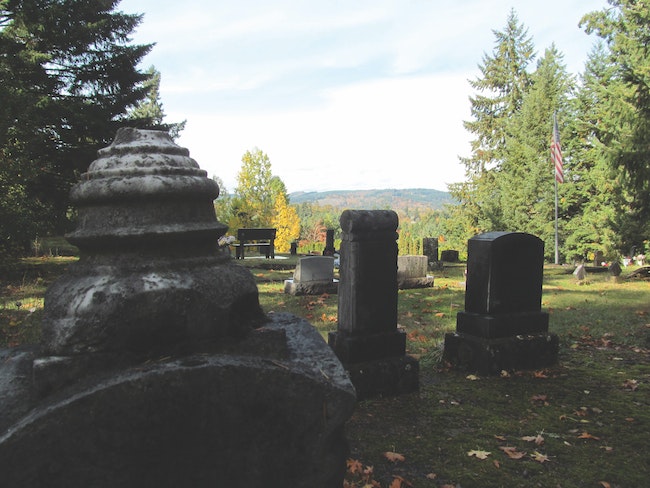 View from the hill that Sarah Alexander chose to be buried on in 1853. DANA MERRYDAY/PHOTO
View from the hill that Sarah Alexander chose to be buried on in 1853. DANA MERRYDAY/PHOTO
Halloween had that weird Sunday edition this year. When locals started putting out their decorations over a month ago, their displays often included mock tombstones. Seeing those got me to move on a reader’s suggestion that it would be nice to hear about local historic cemeteries.
My great-grandfather founded a Funeral Home empire that has grown to serve four counties in the Florida Panhandle and continues as a family-owned business under my cousins. Coming up that way means I have spent a lot of time in cemeteries over the years. Being taken to graveyards where my ancestors lay and being schooled by grandmothers about who is who under those stones, hearing the family stories, and attending burials at those same family plots of ones I had loved growing up. Most recently we gathered again to put our parents’ ashes under a stone saying “We will always be together,” joining other families in repose. Twice I have lived vis-a-vis cemeteries and where I spent many hours in peaceful walks, reading headstones and trying to imagine the person they were.
The Sears Cemetery on Row River Road has a sad founding, if early accounts are to be believed. Settlers Robert and Sarah Alexander, original Donation Land Claim (DLC) recipients, put down their stakes in the Row River Valley in 1853. The young mother suffered from consumption (tuberculosis), then a form of slow death, and she knew her time in this world was short. She picked out a spot that she wanted to be buried, on top of a hill under an oak tree, her home in view. Five months after her request, she was laid to rest there, the first burial in what came to be called Sears Cemetery at Mountain View.
Although I’d been to Sears Cemetery before, I made a special trip to research this article. The surprisingly long, tree canopied road that leads up the hill Sarah Alexander selected to lie, was enveloped with vibrant fall colors. The drive in was quite spectacular! As soon as you start to walk out into the cemetery, the view Alexander wanted to remember jumps out at you. Sarah had a good eye. I also started to look for that Oak tree Mrs. Alexander wanted to lie under. I only saw one small Oak on the premises and it was behind a fence post, not really in the cemetery bounds. I did find a hand-carved tombstone that, while broken, the name “Alexander” was legible along with the dates: Jan, 4, 1833-May 8, 1856.
I found out that this stone marks the grave of Absalom, son of Robert and Sarah. He made a DLC in 1856, then promptly died. His mother’s grave is supposedly marked by a foot stone, by his side, though it is now a Douglas Fir that towers over them,
Digging through the files, I learned that the land for the cemetery was from Alexander’s DLC but another source claims that half the hill was from Sears and the other Alexander’s claims. Regardless, the Sears name has been appended to the burial grounds and Caroll Jackson Sears with wife Jane Carter, do sleep there, along with many of their progeny.
 Gravesite of Caroll Jackson Sears, 1815-1901, and Sarah Carter Sears, 1820-1890.
Gravesite of Caroll Jackson Sears, 1815-1901, and Sarah Carter Sears, 1820-1890.
C.J. Sears, from Sequatchie Valley, Tennessee, made the trek from the east to California for the gold rush in 1850. He did okay, decided to cash in and headed home. He must have liked something he saw here because he soon returned at the head of a train of 75 wagons as captain. He successfully led the party without mishap across the wilderness and settled himself on the Row River in 1853. One of the wagons Sears guided belonged to Sarah and Robert Alexander, who became neighbors when the Alexanders took the adjacent DLC. It is rumored that his old barn, put together with wooden pegs, still exists along Sears Road, which is named for C.J.
Besides the Sears and Alexanders, at least five other DLC holders are buried at Sears Cemetery, Currin, VaSchoiack, Cole, Southwell, and Clark. The fatal feud between these latter two families gave the “Row” River Valley its name. Other early settlers to the area such as the Englands and a few Veatchs have plots and marked stones. Alfred Bigelow, the Postmaster who named the Dorena Post Office, has a permanent address there. Among these pioneers, there is one remarkable personality, J. William “Squire’’ Vaughn.
Somewhat like Judge Roy Bean but far more scrupulous, Vaughn ruled the roost as Justice of the Peace for over 40 years in Cottage Grove. Vaughn and his newly wedded wife, Matheble Daniels. traveled the Oregon Trail as sort of a honeymoon, heading out of Iowa in 1853. The trip was rough, having lost the trail several times and having to survive off the tough meat of some of their animals. They finally made it to the Willamette Valley late in the season. The honeymooners settled in Cloverdale east of Creswell, where Vaughn went about building a flour mill, the first in Lane County. He later moved it to Delight Valley, using flumed water to power the grinding wheels. He would mill customers’ wheat and grain, taking a portion which he would sell to stores throughout the valley. Although slight in frame, barely five feet and 130 pounds, the miller could sling the 100 pound sacks of grain and flour effortlessly.
He lost his first wife in 1863, and life with four kids and a mill was difficult but by the time Vaughn was on a semi-even keel, Bohemia Johnson started a gold rush to the hills with his discovery of rich ore. Vaughn was in one of the first parties that headed up to the mountains to strike it rich. He and his partners were paid for their efforts with sore backs but no gold. While others stuck it out up in the mines, Vaughn headed back to his grist mill. He remarried in 1868, this time to Sina Alexander, who bore him an additional seven children. It was said that even with this large brood of eleven, the Vaughns’ home life was as peaceful as a Sunday School class, not from the heavy hand of punishment but through his embodiment of the golden rule, truly living it. Known to be deeply religious, he never drank and was a founding member of the 1st Presbyterian Church, one of the first organized congregations in the area.
Around 1870 Vaughn served as County Commissioner, but soon found he lacked the temperament for the position. The county had very little money and loud was the call for improvements, particularly with roads. He resigned after a year but was persuaded to run for the newly established Justice of the Peace office in Cottage Grove. Since this was a part-time position it allowed him to run his mill without much interference.
As justice of the peace he married over 300 couples, with $5 being the standard fee. Not too particular, the Judge would take firewood, chickens, or just about anything he could use if the groom was short of cash, a common enough condition in those times. In 1894 Vaughn closed his mill and was to be found in office every day after that. Transportation was better and flour was much easier to get. At 72 the work was physically demanding and besides the young growing town was generating plenty for Judge Vaughn to do. With things up in the Bohemia Mining District going full swing; loggers pouring into town which was well-stocked with brothels and saloons, town life could be quite lively, particularly on Saturday nights when the two groups would dust things up.
Despite his position, Vaughn dispensed justice with a tolerant hand. He didn’t judge a person for their shortcomings and was far from a “do-gooder.” Such was his reputation for treating everyone one and the same under the law and his unquestioned honesty, that he became such a fixture in his office that few considered running against him. One man, Alta King, tried many times to unseat the Judge, but all of his stumping around and politicking never had any measurable results, Vaughn was reelected each time by wide margins.
Finally tired at ninety from years of toil, Squire Vaughn retired and took to a rocking chair on his front porch. He recommended King to replace him, who finally got his chance to serve after all of his years of effort to get the job. At 95, shortly before his death, he spoke at a meeting of the Cottage Grove Masons, honoring older members, Vaughn himself having been a member since the 1850s. Everyone was impressed by the wit and vitality of this nonagenarian. He passed peacefully, the doctor saying he just wore out, like an old watch. For all his contributions to the community his stone simply records his name, birth and death years with no mention of his status or service to our town.
Scattered among the old graves are a surprising number of children’s graves. Life was hard in the days before vaccines and antibiotics. Measles, Croup, Diphtheria, and simple infections carried off many before their time. Here are few: Ida Cole June 11, 1872-Dec 10, 1872, Lila Mae Walker June 24, 1904-Jan 13, 1906, Ethel Vaughn aged 1 Year, 10 Months, and 10 days.
While Sears holds some of the area’s earliest notables, it is an active burial ground. Plots are available and managed by the Sears Cemetery Association. This was not always the case. By 1960 the graveyard had fallen into a state of neglect. A group of concerned citizens, some with family interred there, got together to rectify this situation. In a 1994 Sentinel article, Eugene Nelson, related that when he got involved in the care and upkeep there was no map or records of the burials. One of the volunteers first tasks was to try and locate, identify, and map all of the existing plots and graves. It is certain that there are unmarked graves there. Some were located by wooden markers long rotted away, or during hard times when no stone could be afforded and as time moves on memories fade and are lost.
There is a stark contrast in the styles and form of the tombstones. Ones from the 1800s have a simple elegance and often religious themes. More recent burials often express the deceased’s interests. The grave of a youth who passed too soon showed a skateboard and dirt bike. Another depicts the buried rider riding his custom motorcycle. Two unique graves really caught my eye. One was an electric guitar being played by hands that reach out of the dirt. The other is marked by a cross fashioned out of old chainsaw bars with the epithet at the bottom “I saw a man.”
And while folks famous for settling the area rest here, there are many others who have left their mark on Cottage Grove. Artists Helen and Susan “Sujo” Tryk, rest among the others who lived, worked, and died here adding their special touch to our community. Remember those who came before us, especially on All Souls’ Day, and look for more historic cemetery notes in the future.
Email: [email protected]








